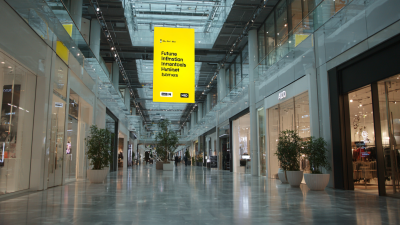



In the rapidly evolving landscape of branding, the significance of design signage cannot be overstated. As we approach 2025, the design signage industry is projected to surpass a staggering $50 billion, underscoring its pivotal role in capturing consumer attention and enhancing brand identity. A recent study by IBISWorld highlights that the demand for innovative signage solutions is driven not only by retail environments but also by the growing emphasis on experiential marketing, where businesses aim to create immersive brand experiences. This surge in market value reflects an increasing recognition of how effective design signage can navigate the complexities of visual communication in today’s crowded marketplace.

From dynamic digital displays to sustainable materials, the trends shaping design signage are diverse and impactful. The Data-Driven Marketing Association reports that brands utilizing integrated signage strategies see up to a 25% increase in customer engagement, illustrating the measurable effects of thoughtful design. As companies continue to allocate substantial budgets towards creative signage solutions, understanding the top trends of 2025 will be crucial for marketers looking to leverage this $50 billion industry effectively. In this discussion, we will explore the top five design signage trends that are set to redefine the interaction between consumers and brands in the coming years.
The digital signage industry is rapidly transforming branding strategies across various sectors, with an estimated market value of $50 billion by 2025. As businesses recognize the dynamic nature of digital displays, they are leveraging this technology to enhance customer engagement and create memorable brand experiences. One compelling aspect of digital signage is its ability to deliver real-time updates and personalized content, which not only captivates audiences but also drives conversion rates.
**Tips for Effective Digital Signage:**
1. Ensure content is visually appealing and easy to digest. Use high-quality images and concise messaging to grab attention quickly.
2. Utilize data analytics to tailor content to specific demographics and locations, ensuring that your message resonates with your audience.
3. Regularly update your signage to keep the content fresh and relevant, encouraging repeat visits and sustained interest in your brand.
This rising influence of digital signage means that brands must stay ahead of the curve by adopting innovative technologies and strategies. Integrating interactive elements, such as touch screens and QR codes, can further enrich customer interaction, making the overall experience more engaging and informative. By embracing these advancements, brands can build a stronger connection with their audience, ultimately leading to enhanced loyalty and brand recognition.

As the signage industry continues to evolve, a significant shift towards sustainable materials is gaining momentum. Businesses are increasingly recognizing the importance of eco-friendly design, not only to enhance their branding but also to contribute positively to the environment.
From biodegradable substrates to recycled metals and eco-friendly inks, modern signage solutions are moving away from traditional materials that harm the planet. This trend is not just about aesthetic appeal; it reflects a growing consumer demand for responsible practices and a commitment to sustainability.
Tips for incorporating sustainable materials in your signage include researching suppliers who prioritize eco-friendly options, such as those offering recycled or sustainably sourced materials. Additionally, consider the longevity of the materials you choose; durable signage not only reduces waste but also cuts down on maintenance costs over time. Another effective strategy is to implement a design that can be easily updated or repurposed, ensuring your investment can adapt to future branding needs without creating excess waste.
As the push for sustainability in the signage industry grows, brands that lead in eco-friendly practices will likely stand out in a crowded market. By embracing these trends, companies can not only enhance their image but also contribute to a more sustainable future.
Interactive signage has emerged as a crucial element in enhancing customer engagement within retail spaces, revolutionizing how brands connect with consumers. Unlike traditional static signage, these dynamic displays allow for real-time interaction, fostering a more immersive shopping experience. For instance, touchscreens or motion-sensor technology can facilitate product exploration, enabling customers to access detailed information, view promotional content, or even participate in interactive quizzes tailored to their interests. This level of engagement not only captures attention but also encourages longer dwell times, ultimately leading to increased sales.
Furthermore, the integration of adaptive technologies in interactive signage can personalize the shopping experience. Retailers can implement data-driven insights to tailor content based on customer behavior, preferences, and demographic information. This personalization aspect transforms the retail environment, creating a sense of connection between the brand and the consumer. By leveraging interactive signage, retailers not only enhance customer engagement but also create memorable experiences that resonate with shoppers, setting their brand apart in the competitive landscape. As this trend continues to evolve, the potential for interactive signage to drive both engagement and brand loyalty in retail spaces remains significant.
The integration of Augmented Reality (AR) into signage solutions is revolutionizing the way brands engage with their audiences. A recent report by ResearchAndMarkets indicates that the global AR market is set to reach $198 billion by 2025, reflecting its potential to transform industries, including signage. By enhancing traditional static displays with interactive digital elements, businesses can create immersive experiences that capture consumer attention and drive brand loyalty.
AR technologies enable users to access additional information, promotions, and interactive content simply by scanning signage with their smartphones. According to a study by Statista, approximately 56% of consumers expressed a preference for interactive advertising experiences, highlighting the effectiveness of AR in capturing customer interest. This shift not only enhances the consumer experience but also allows brands to collect valuable data on user interactions, enabling them to tailor their marketing strategies more effectively. As the signage industry continues to evolve, embracing AR will be essential for brands looking to make a lasting impact in the increasingly competitive $50 billion market.

In the rapidly evolving signage industry, harnessing the power of data analytics is becoming a game-changer for brands vying for visibility in a competitive marketplace. According to recent studies, businesses that incorporate data-driven strategies in their signage can experience up to a 30% increase in customer engagement. This shift towards analytics not only helps refine brand messaging but also assists in making informed decisions about signage placements and content based on real-time consumer behavior.
Utilizing analytics allows brands to track which signage messages resonate most with their target audience. For instance, A/B testing of different designs can reveal insights into consumer preferences that significantly influence purchasing decisions. This data-centric approach fosters a deeper connection between the brand and its customers, which, when executed well, can elevate a brand’s presence in the $50 billion signage industry.
**Tip 1:** Regularly review and analyze the performance of your signage through metrics such as foot traffic and conversion rates to understand what works best for your brand.
**Tip 2:** Engage with your audience through interactive signage that allows for real-time feedback; this can provide invaluable data to further refine your messaging strategy.
Integrating analytics into signage strategy not only optimizes brand messaging but ensures that every sign is a step towards stronger brand recognition and loyalty.






